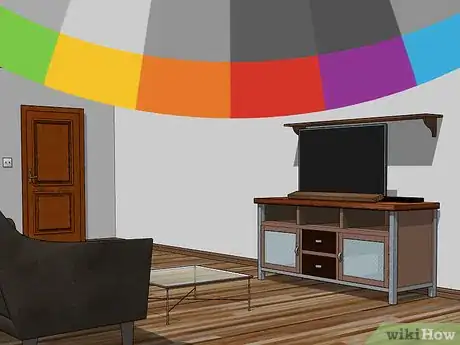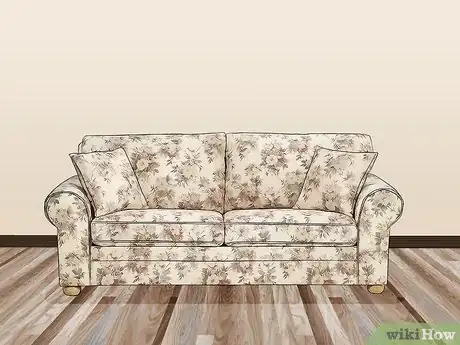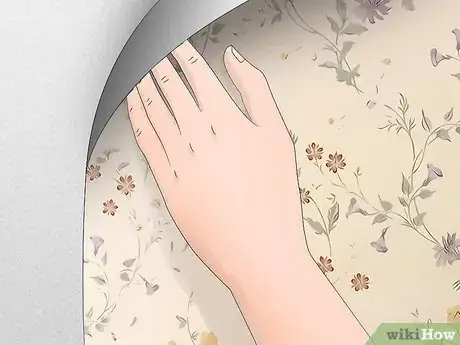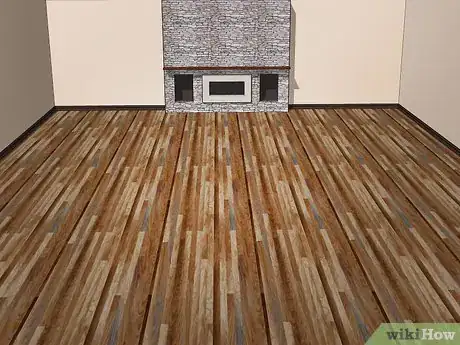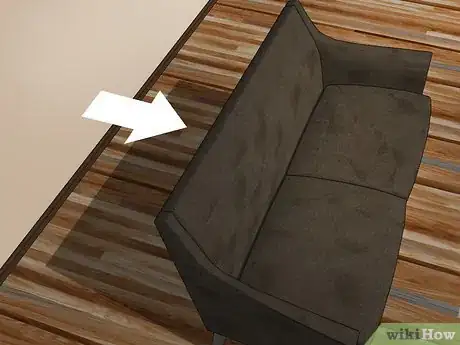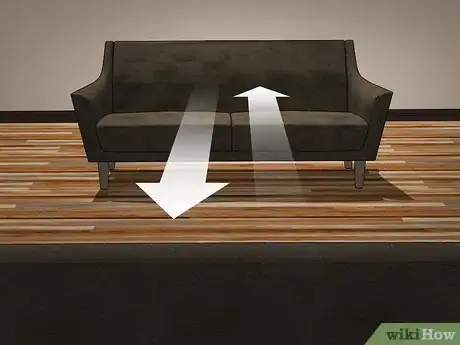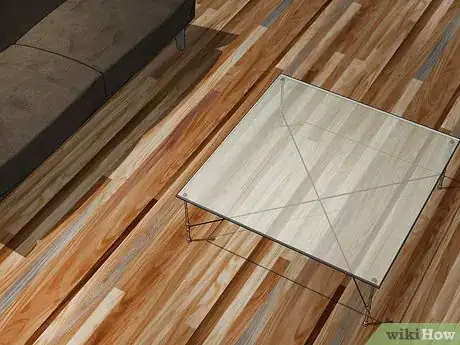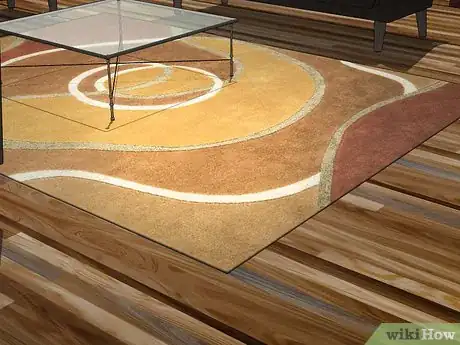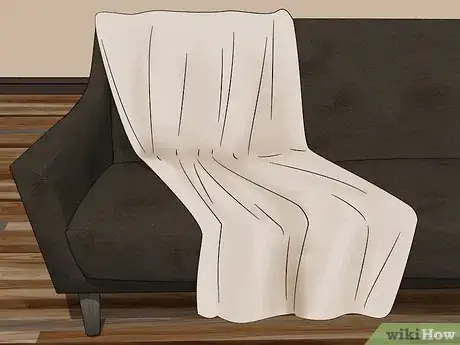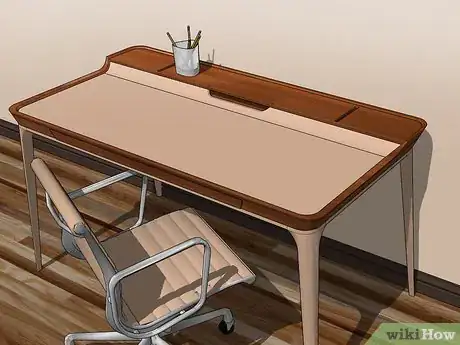This article was co-authored by MacKenzie Cain. MacKenzie Cain is an Interior Designer and a LEED-certified Green Associate for Habitar Design based in Chicago, Illinois. She has over seven years of experience in interior design and architectural design. She received a BA in Interior Design from Purdue University in 2013 and received her LEED Green Associate certification from the Green Building Certification Institute in 2013.
There are 12 references cited in this article, which can be found at the bottom of the page.
This article has been viewed 51,846 times.
Decorating your living room might seem like a daunting task, especially if you never done it before. Whether you have plenty of room or are squeezing into a small space, you can make your living room comfortable and inviting. By arranging your furniture with purpose and accenting according to a color scheme, you can decorate your living room like a pro.
Steps
Choosing a Color Scheme
-
1Choose a color palette and stick to it. Pick 2-3 accent colors that complement your furniture and wall color, and choose accessories that follow the color scheme. The main accent color should appear in the room at least 3 times to really stand out.[1]
- For example, if your seating is gray, and your walls are white or tan, you might choose turquoise and yellow as your accent colors.
- If most of your furniture is brown, you might pick warmer colors, like burgundy and violet, as your accents.
- For small spaces, go with mostly light colors and warm neutrals.[2]
- As an alternative to using accent colors, choose a monochromatic theme. You could do your living room all in neutrals or shades of blue, for instance.
EXPERT TIPKatherine Tlapa is an interior designer, currently working as a Design Specialist for Modsy, a design service based in San Francisco. She also runs her own DIY Home Design blog, My Eclectic Grace. She received her BFA in Interior Architecture from Ohio University in 2016.Interior Designer
 Katherine Tlapa
Katherine Tlapa
Interior DesignerKatherine Tlapa, an interior designer, advises: "Living rooms look best in neutral colors. If you have warm colors in your space, stick to warm tones like taupe, beige and warm grey. If you have cool colors throughout your home, use cool tones like cool grey, light blue, and bright whites. You can have an accent wall too, which is popular."
-
2Draw inspiration from a piece of fabric or art that will be in the room. Most pieces of art and fabrics are designed with color theory in mind, so they’re great for inspiring a theme. Pick 2-3 main colors from the item, and think about why you like the style of that particular item.[3]
- For example, you might have an old painting of an open field with a farmhouse that incorporates green, grey, and pastel blue. You could create a rustic farmhouse theme that includes those colors as accents, and position the painting as the focal point of the room.
- Alternatively, use a favorite piece of furniture for inspiration. For example, design the room based off of a floral-patterned sofa with curved lines.
Advertisement -
3Apply a fresh coat of paint to coordinate with your new color scheme. Start by picking out the most neutral color in your color scheme, like a tan, light gray, pastel yellow, or light blue. Carefully prime, and then paint all of the walls with 2-3 coats of your chosen color. If you don’t have a lot of painting experience, consider hiring a professional for the job.[4]
- Try to paint the room before you place your furniture, or be sure to protect the furniture with cloths or tarps.
- If you know you’re going to be living in the home for more than 5 years, feel free to experiment with bolder colors.
- Use a neutral paint color if you want a versatile space or like to change your decor every so often.
-
4Hang patterned wallpaper on a feature wall to pull the theme together. Wallpaper is an excellent way to draw attention to one area of the room. Choose a bold, large print that incorporates 1-2 colors in your scheme, and a neutral color such as black, white, brown, or grey.[5]
- Or, place the wallpaper in a nook or built-in for a subtle effect.
- Wallpaper prints that are very small, such as tiny florals, can make the room seem smaller. Try to stick with prints that are more than 1 ft (0.30 m) tall and clearly visible from across the living room.
- When hanging wallpaper, work slowly and carefully. If you don’t have experience hanging wallpaper, consider hiring a professional to do the job for you.
Arranging Your Furniture
-
1Pick a focal point for the room. Whether it’s a fireplace, a piece of art, an entertainment center, or even a picturesque window, choose a spot or direction to act as the main feature of the room. Then, you can position your furniture around that point.[6]
- If you don’t have a special feature in your living room, make one! You can even use a central table as the focus of the room to encourage conversation.
- It makes the most sense to use the largest piece of furniture you have as the focal point. For example, hang a painting over a sofa and layer throw pillows on it.
-
2Keep most of your furniture away from the walls. Although it may seem like a good idea, refrain from pushing your couch or chairs up against the wall. Instead, position your couch or chairs around the focal point of the room, with the back of the furniture away from the wall.[7]
- Aim to create a seating area in the center of the space.
- As a general rule, pull seating at least 1 foot (0.30 m) away from the wall to make the room seem more inviting.
- Pieces like bookshelves are normally built to lean against a wall, so it’s okay to place them there.
-
3Leave walking space between pieces of furniture. There’s nothing more frustrating than bumping into furniture while you’re trying to walk through a room. Create at least 3 feet (0.91 m) of space between all major pieces of furniture, like sofas, and 18 inches (46 cm) between minor pieces, like end tables.[8]
- Always leave plenty of space in the entryway of a room so that guests can navigate. Don’t block doorways, hallways, and major pass-ways in the room. Similarly, don’t face the back of a chair or sofa to the entryway, as this creates a closed-in feel.
-
4Arrange seating so that guests can see each other. When positioning your couch, sofa, and chairs in the room, turn them to face each other. Even if the room has a focal point like a television or fireplace, guests will still want to talk to each other.
- To encourage conversation but also draw attention to the main feature of the room, angle the seating so that it’s facing the focal point, but turned slightly toward the other chairs or couches.
Picking Accents
-
1Place an end table or coffee table within reach of your seating. Tables are both appealing and functional pieces of furniture. As a general rule, each piece of seating furniture should have some sort of table within reach. If possible, select a coffee table that is light, so you can easily move it if necessary.
- Your tables don’t necessarily have to match, but they should have a cohesive look. For instance, if your coffee table is reclaimed wood, try to stick with other wooden tables to fit the theme of the room.
- In addition to choosing tables that fit the look of your living room as a whole, you can also style your coffee table or end tables with additional accents that match the look, such as books or plants.
-
2Position an area rug near the seating area to pull the room together. Choose a rug that compliments the color of your seating, the flooring, and your accent colors. It should be cohesive with the space, but can still be a focal point. Make sure it’s large enough to fit under the seating area, but not so large that it takes up the whole room. Position it in the center of the seating area to pull the space together.
- Area rugs work well even on carpeted floors, as long as they don’t clash too much with the color of the carpet.
- For added safety on wood or laminate floors, place sticky webbing from the home improvement store under the rug. The webbing will keep it from slipping when someone steps on it!
-
3Include light fixtures throughout the room to illuminate darker areas. Many living rooms have insufficient overhead lighting, or none at all. If you have an area of your living room that doesn’t get much light, place a table lamp or floor lamp there to brighten up the space as needed.#*For small spaces, go with mostly light colors and warm neutrals.[9] [10]
- If you want a more coordinated look, pick up 2 matching lamps and place them on opposite ends of the room.
- Or, update your existing lamps by painting the bases and swapping out the shades.
- Make sure that the light fixtures and shades are positioned in a way that doesn’t obstruct anyone’s view.
-
4Select a few pieces of art to hang on the walls. Hang fun art or pictures of your family around the room at about eye level. Try to avoid having more than 2-3 pieces of art in the room, as it can make the space feel overly cluttered. When in doubt, refer to your color scheme for art inspiration![11]
- Pick pieces that have meaning to you. For instance, if you really like Van Gogh’s Starry Night, buy a print of the image and have it framed.
-
5Spice up a sofa or loveseat with fun throw pillows. To decorate a couch or sofa, pick 3-5 pillows that complement the sofa and match your color scheme. For chairs, pick only 1 pillow per chair. On the couch, position 1-2 throw pillows at each end, and, if the couch is longer, place a pillow in the middle as well.[12]
- Play around with various patterns, shapes, sizes, and textures to see what works best for the room.
-
6Experiment with throw blankets draped over your couch or ottoman. To make the room seem more cozy and inviting, position a throw blanket or 2 over the back of the couch or folded on top of an ottoman. Pick a blanket in one of your accent colors, or choose one that is an interesting fabric, like faux fur.[13]
- If you have a lot of different throw blankets, consider making them a feature of the room by leaning a wooden ladder against a wall. Then, fold a blanket over each rung so that they’re on display, and guests can take one to use if they want to!
-
7Select 1-2 accessories or pieces of furniture that serve a purpose. If you have a hobby or activity that you always do in the living room, place your tools purposefully to showcase your interests. Position them as an art feature, or make a special corner of the room just for your hobby.[14]
- For instance, if you write in the living room, set up a small writing desk with a notebook, pen cup, and a unique chair along a wall or near a window.
- If you like to listen to records or read magazines in the living room, consider getting a stand for your record player or a magazine rack to place in the room.
- If you do a lot of entertaining, add a wheeled bar cart to the space.
-
8Check local yard sales and online marketplaces for unique accent furniture. Sites like Craigslist and events like estate sales tend to have interesting furniture and accents available for very low prices. Search around and see if you can find that perfect piece of art or a brightly colored end table to pull the room together!
- Even if you find furniture or pictures that aren’t perfect, you can still get a great deal. Then, do a DIY makeover to turn your find into the perfect accent for your living room.
Community Q&A
-
QuestionWhat kind of living room pieces should I use for a small space?
 MacKenzie CainMacKenzie Cain is an Interior Designer and a LEED-certified Green Associate for Habitar Design based in Chicago, Illinois. She has over seven years of experience in interior design and architectural design. She received a BA in Interior Design from Purdue University in 2013 and received her LEED Green Associate certification from the Green Building Certification Institute in 2013.
MacKenzie CainMacKenzie Cain is an Interior Designer and a LEED-certified Green Associate for Habitar Design based in Chicago, Illinois. She has over seven years of experience in interior design and architectural design. She received a BA in Interior Design from Purdue University in 2013 and received her LEED Green Associate certification from the Green Building Certification Institute in 2013.
Interior Designer & LEED Green Associate Utilize multi-function furniture pieces to limit the number of pieces needed in the room. Keep the furniture pieces clean and simple rather than heavy and bulky. Overall, keep the room layout simple and don’t overcrowd the room with too many pieces of furniture or accessories.
Utilize multi-function furniture pieces to limit the number of pieces needed in the room. Keep the furniture pieces clean and simple rather than heavy and bulky. Overall, keep the room layout simple and don’t overcrowd the room with too many pieces of furniture or accessories. -
QuestionHow can we decorate our living room?
 Katherine TlapaKatherine Tlapa is an interior designer, currently working as a Design Specialist for Modsy, a design service based in San Francisco. She also runs her own DIY Home Design blog, My Eclectic Grace. She received her BFA in Interior Architecture from Ohio University in 2016.
Katherine TlapaKatherine Tlapa is an interior designer, currently working as a Design Specialist for Modsy, a design service based in San Francisco. She also runs her own DIY Home Design blog, My Eclectic Grace. She received her BFA in Interior Architecture from Ohio University in 2016.
Interior Designer There are many ways to decorate your living room. Determine how you want to use the space and what style you like best. Make an inspiration board or find a picture you can use to guide you and find items you like for the room. Remove anything from the living room that you don't like or need, as this will make it easier to decorate.
There are many ways to decorate your living room. Determine how you want to use the space and what style you like best. Make an inspiration board or find a picture you can use to guide you and find items you like for the room. Remove anything from the living room that you don't like or need, as this will make it easier to decorate. -
QuestionHow can I make my living room beautiful?
 Katherine TlapaKatherine Tlapa is an interior designer, currently working as a Design Specialist for Modsy, a design service based in San Francisco. She also runs her own DIY Home Design blog, My Eclectic Grace. She received her BFA in Interior Architecture from Ohio University in 2016.
Katherine TlapaKatherine Tlapa is an interior designer, currently working as a Design Specialist for Modsy, a design service based in San Francisco. She also runs her own DIY Home Design blog, My Eclectic Grace. She received her BFA in Interior Architecture from Ohio University in 2016.
Interior Designer Decide what looks beautiful to you! If you love a certain color or style, then go for it! Adding light and more texture to your space can make a space more pleasing.
Decide what looks beautiful to you! If you love a certain color or style, then go for it! Adding light and more texture to your space can make a space more pleasing.
References
- ↑ http://www.idealhome.co.uk/living-room/living-room-ideas/living-room-colour-schemes-89978
- ↑ MacKenzie Cain. Interior Designer & LEED Green Associate. Expert Interview. 4 July 2020.
- ↑ https://www.bhg.com/decorating/color/schemes/how-to-pick-a-color-scheme/?slideId=b8f14b85-13e1-4bf4-af00-d37231a68f0f
- ↑ https://www.countryliving.com/home-design/color/a18928730/joanna-gaines-paint-workshop/
- ↑ https://www.bhg.com/decorating/color/schemes/how-to-pick-a-color-scheme/?slideId=7e9a9a8f-d986-44ab-91ec-932b52811859
- ↑ https://www.bhg.com/decorating/lessons/basics/how-to-arrange-furniture/?slideId=7e9c32f5-c43c-4d72-aab0-1e46eb535c03
- ↑ https://www.apartmenttherapy.com/dont-make-these-mistakes-when-arranging-your-living-room-215870
- ↑ https://www.apartmenttherapy.com/dont-make-these-mistakes-when-arranging-your-living-room-215870
- ↑ MacKenzie Cain. Interior Designer & LEED Green Associate. Expert Interview. 4 July 2020.
- ↑ https://www.architecturaldigest.com/story/living-room-lighting-ideas
- ↑ https://www.homedit.com/how-to-choose-art-for-your-living-room/
- ↑ https://www.architecturaldigest.com/story/throw-pillows-formulas
- ↑ https://aprettyfix.com/decorating-101-throw-pillows-blankets-can-make-space-look-better-instantly/
- ↑ https://www.housebeautiful.com/home-remodeling/interior-designers/tips/g1019/how-to-decorate-with-accessories-1210/?slide=7
About This Article
To decorate your living room, start by choosing a color palette of 2-3 colors that you like. Then, look for accessories, like pillows, throw blankets, and lampshades, that match your color scheme. Also, put out a nice table lamp or floor lamp to help illuminate the room and make it cozy. If the walls are looking bare, hang up some fun artwork and family photos. To give your room a pop of color, get a vibrant area rug and position it near the seating area. For tips on arranging the furniture in your living room, scroll down!
